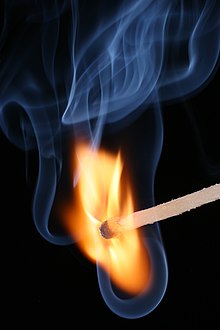Ignition temperature
The ignition temperature (also flash point , autoignition temperature , ignition temperature or flash point is) the temperature to which one a material or a contact surface must be heated, so that a combustible substance ( solid , liquid whose vapors or gas ) in the presence of oxygen exclusively due to its temperature - i.e. without an ignition source like an ignition spark - self-ignited . It is different for each fabric and in many cases depends on the pressure. Self-ignition is caused by an exothermic oxidation reaction when the rate of heat production exceeds the heat dissipation through conduction , radiation and convection . The ignition temperature does not correlate with the boiling point or flash point temperature of a flammable substance. Rather, it is a measure of the substance's sensitivity to oxidation.
The auto-ignition temperature is not a material parameter in the true sense, as it depends in particular on the volume of the substance under consideration. Larger volumes ignite at lower temperatures. The time to self-ignition can be months. The theory of the heat explosion deals with the calculation of the auto-ignition temperature. It proposes a concept that allows the physical properties and self-ignition temperature of self-igniting materials to be clearly determined by means of warm storage tests. The kinetic parameters relevant for the numerical simulation are obtained in adiabatic hot storage tests. The auto-ignition temperature is important for fire protection , for example in drying processes, storage and transport. In coal seam fires and some other fires, ignition can also occur in situ , i.e. in the natural formation of coal seams .
Gases
At significantly lower flash point a can of gas - air mixture of the same substance only by means of the ignition source are inflamed. At its flash point temperature, a liquid reaches a vapor pressure and thus a saturation vapor concentration that is so high that the corresponding gas-air mixture can be ignited.
The ignitability of a gas mixture also depends on the oxygen content of the surrounding atmosphere. Normal conditions refer to 21% oxygen in air. Since large systems (tanks, containers) cannot be inertized with nitrogen up to a residual oxygen content of 0% , the minimum required limit oxygen content for ignition is determined in special measurements (e.g. 2 to 4%).
liquids
Solvent
Solvents with particularly low ignition temperatures (approx. 120–180 ° C) are:
- acetaldehyde
- Carbon disulfide - a hot glass rod is enough to ignite.
- Diethyl ether
- Ethylene glycol dimethyl ether
- Propylene glycol dimethyl ether
- Diethylene glycol dimethyl ether and dipropylene glycol dimethyl ether - can self-ignite during distillation on hot apparatus parts, with dipropylene glycol dimethyl ether the ignition temperature is 10 ° C below the boiling point (see flash point )
Oils and fats
If laundry is improperly cleaned and heated, vegetable oils or animal fats can catch fire at temperatures above 70 ° Celsius. In particular when using tumble dryers or ironers, there is an increased risk of these processes, which can quickly lead to a fire in the entire device.
Solids
Dusts
- Coal dust
- Flour dust
- see also: Dust explosion - conditions of ignition of dusts
particularities
- White phosphorus - quickly ignites automatically in air (principle of the phosphor bombs in World War II ).
- Oil-smeared rags - can self-ignite when lying in waste bins for a long time.
- Pyrophoric iron - consists of ultra-fine iron filings, melted in ampoules under inert gas. When pouring out , a shower of sparks forms in the air , similar to metal chips when grinding .
- Electrostatically charged powders (e.g. some synthetic resin powders and polymer granulates, methyl-substituted cellulose derivatives) - are formed when pouring out of transport packaging. Potential ignition sources on the one hand and explosive dust on the other hand are present at the same time.
Tables
Ignition temperature of some solids:
|
Ignition temperature and flash point of some liquid fuels:
|
Ignition temperature of some gases at normal pressure:
|
literature
- Roy Bergdoll, Sebastian Breitenbach: Die Roten Hefte, Issue 1 - Burning and Extinguishing . 18th edition. Kohlhammer, Stuttgart 2019, ISBN 978-3-17-026968-2 .
See also
- Ignition limit
- Combustion triangle
- Deflagration temperature
- Minimum ignition charge
- Drip ignition point
Individual evidence
- ↑ Self-ignition of laundry - fats and oils are to blame , Vorarlberg Fire Prevention Office, accessed on August 8, 2018
- ↑ Self-ignition of laundry , Hetzel laundry machines, accessed on August 8, 2018
- ↑ Flash point and ignition temperature: gasoline at www.chemieunterricht.de
- ↑ Petroleum data sheet (PDF) from Merck , accessed on March 10, 2014.
- ↑ Data sheet of a turpentine oil ( Memento from January 25, 2005 in the Internet Archive )
